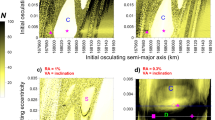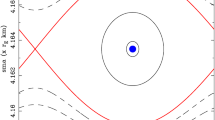Abstract
The Cassini spacecraft discovered many close-in small satellites in Saturnian system, and several of them exhibit exotic orbital states due to interactions with Mimas and the oblateness of the planet. This work is devoted to Methone, which is currently involved in a 15:14 mean-motion resonance with Mimas. We give an in-deep study on the current orbit of Methone by analyzing and identifying the short, resonant and long-term gravitational perturbations on its orbit. In addition, we perform numerical integrations of full equations of motion of ensembles of close-in small bodies orbiting the non-central field of Saturn. Spectral analyses of the orbits and interpretation of them in dynamical maps allow us to describe the orbit and the dynamics of Methone in view of resonant and long-term dynamics. We show that the current geometric orbit of Methone is aligned with Mimas’ due to a forced resonant component in eccentricity, leading to simultaneous oscillations of several critical angles of the expanded disturbing function. Thus, we explain the simultaneous oscillations of four critical arguments associated to the resonance. The mapping of the Mimas–Methone resonance shows that the domains of the 15:14 Mimas–Methone resonance are dominated by regular motions associated to the Corotation resonance located at eccentricities lower than \(\sim \, 0.015\) and osculating semi-major axis in the interval 194,660–194,730 km. Methone is currently located deeply within this site.









Similar content being viewed by others
Notes
We will define and denote the angles \(\psi _2\equiv 15\lambda _{\mathrm{Me}}-14\lambda _{\mathrm{M}}-\varpi _{\mathrm{Me}}\) and \(\psi _1\equiv 15\lambda _{\mathrm{Me}}-14\lambda _{\mathrm{M}}-\varpi _{M}\) by the Lindblad and corotation angles, respectively. This nomenclature comes from planetary ring dynamics (e.g., Murray and Dermott 1999).
On the contrary to the example given above, the dynamics of the resonance 15:14 Mimas–Methone is dictated within the domain of the restricted three-body problem (El Moutamid et al. 2014), since the mass of Mimas is much larger than Methone’s.
Recall that ephemerides are limited to a hundred of years, so that numerical simulations are able to cover the long-term components.
This result has been shown in Callegari and Yokoyama (2020) in the case of the satellite Anthe, and the same should be directly applied to any other close-in small satellite of Saturn in Corotation resonance with Mimas.
Recall that the forced eccentricity, roughly indicated by vertical dashed line, is measured from the center of the coordinate system, while the proper mode is taken from the forced center.
The other initial elements in the simulation are the same than those of Methone at the date 2016-01-01; \(a_0=194{,}775\) km has been taken from Fig. 7. As discussed in item (i) in Sect. 5.1, at this initial conditions, the test particle is sufficiently far enough of the chaotic layers of the Corotation zone.
Evidently, this conclusion is valid within in timescale utilized in this work (limited to tens of thousands of years).
Exactly over the boundaries of the Corotation resonance, the continuations are broken, which is another possible indicator of chaoticity at the separatrices.
For instance, by adopting \(P_{\Delta \varpi }=2408.21\) days and \(P_{\psi _1}=521.57\) days, we have \(P_{(\psi _1+\Delta \varpi )}=428.718\) days from the expression: \(\frac{1}{P_{(\psi _1+\Delta \varpi )}}=\frac{1}{P_{\psi _1}}+\frac{1}{P_{\Delta \varpi }}\).
\(\chi \) is defined in equation 25 in El Moutamid et al. (2014), and its expression can be obtained from their Table 1. We utilize \(\chi =k\left[ \frac{ \sqrt{2} }{2} \left( \frac{a-a_0}{a_0}\right) +14e^2\left( \frac{ \sqrt{2} }{2}-1\right) \right] \), where a, e are the osculating semi-major axis and orbital eccentricity of the test particle; k is a function of the masses, orbital elements of Mimas and \(\mathbf{a}_0\), the reference center of the Corotation zone, where we adopt \(\mathbf{a}_0=194{,}683\) km.
References
Brouwer, D., Clemence, G.M.: Methods of Celestial Mechanics. Academic Press, New York (1961)
Callegari, N., Jr., Yokoyama, T.: Dynamics of two satellites in the 2:1 mean-motion resonance: application to the case of Enceladus and Dione. Celest. Mech. Dyn. Astr. 98, 5–30 (2007)
Callegari, N., Jr., Yokoyama, T.: Dynamics of Enceladus and Dione inside the 2/1 mean-motion resonance under tidal disspation. Celest. Mech. Dyn. Astr. 102, 273–296 (2008)
Callegari, N., Jr., Yokoyama, T.: Numerical exploration of resonant dynamics in the system of Saturnian inner Satellites. Planet. Space Sci. 58, 1906–1921 (2010a)
Callegari N., Jr., Yokoyama, T.: Long-term dynamics of Methone, Anthe and Pallene. In: Icy Bodies of the Solar System, Proceedings of the International Astronomical Union, IAU Symposium, vol. 263, pp. 161–166 (2010b)
Callegari, N., Jr., Yokoyama, T.: Dynamics of the 11:10 Corotation and Lindblad resonances with Mimas, and application to Anthe. Icarus 348, 113820 (2020)
Chambers, J.E.: A hybrid sympletic integrator that permits close encounters between massive bodies. Mon. Not. R. Astron. Soc. 304, 793–799 (1999)
Danby, J.M.A.: Fundamentals of Celestial Mechanics. Willmann-Bell Inc., Virginia (1988)
El Moutamid, M., Renner, S., Sicardy, B.: Coupling between Corotation and Lindblad resonances in the elliptic planar three-body problem. Celest. Mech. Dyn. Astr. 118, 235–252 (2014)
Everhart, E.: An efficient integrator that uses Gauss–Radau spacings. IAU Coloquium 83, 185–202 (1985)
Ferraz-Mello, S.: First-order resonances in satellites orbits. In: Ferraz-Mello, S., Sessin, W. (eds.) Resonances in the Motion of the Planets, Satellites and Asteroids, pp. 37–52. IAG/USP, Sao Paulo (1985)
Greenberg, R.: Apsidal precession of orbits about an oblate planet. Astron. J. 86, 912–914 (1981)
Hedman, M.M., Murray, C.D., Cooper, N.J., Tiscareno, M.S., Beurle, K., Evans, M.W., Burns, J.A.: Three tenous rings/arcs for three tiny moons. Icarus 199, 378–386 (2009)
Jacobson, R.A., Spitale, J., Porco, C.C., Owen, W.M., Jr.: The \(GM\) values of Mimas and Tethys and the libration of Methone. Astron. J. 132, 711–713 (2006a)
Jacobson, R.A., Antreasian, P.G., Bordi, J.J., Criddle, K.E., Ionasescu, R., Jones, J.B., Mackenzie, R.A., Meek, M.C., Parcher, D., Pelletier, F.J., Owen, W.M., Jr., Roth, D.C., Roundhill, I.M., Stauch, J.R.: The gravity field of the Saturnian system from satellite observations and spacecraft tracking data. Astron. J. 132, 2520–2526 (2006b)
Jacobson, R.A., Spitale, J., Porco, C.C., Beuele, K., Cooper, N.J., Evans, M.W., Murray, C.D.: Revised orbits of Saturn’s inner satellites. Astron. J. 135, 261–263 (2008)
Michtchenko, T.A., Ferraz-Mello, S.: Modeling the 5:2 mean-motion resonance in the Jupiter–Saturn planetary system. Icarus 149, 357–374 (2001a)
Michtchenko, T.A., Ferraz-Mello, S.: Resonant structure of the outer solar system in the neighborhood of the planets. Astron. J. 122, 474–481 (2001b)
Munõz-Gutiérrez, M.A., Giuliatti Winter, S.: Long-term evolution and stability of Saturnian small satellites: Aegaeon, Methone, Anthe and Pallene. Mon. Not. R. Astron. Soc. 470, 3750–3764 (2017)
Murray, C.D., Dermott, S.F.: Solar System Dynamics. Cambridge University Press, Cambridge (1999)
Peale, S.J.: Origin and evolution of the natural satellites. Annu. Rev. Astron. Astrophys. 37, 533–602 (1999)
Porco, C.C., Baker, E., Barbara, J., Beurle, K., Brahic, A., Burns, J.A., Charnoz, S., Cooper, N., Dawson, D.D., Del Genio, A.D., Denk, T., Dones, L., Dyudina, U., Evans, M.W., Giese, B., Grazier, K., Helfenstein, P., Ingersoll, A.P., Jacobson, R.A., Johnson, T.V., McEwen, A., Murray, C.D., Neukum, G., Owen, W.M., Perry, J., Roatsch, T., Spitale, J., Squyres, S., Thomas, P., Tiscareno, M., Turtle, E., Vasavada, A.R., Veverka, J., Wagner, R., West, R.: Cassini imaging science: initial results on Saturn’s rings and small satellites. Science 307, 1226–1236 (2005)
Porco, C.C.: S/2004 S 1 and S/2004 S 2. IAU Circ. 8401 (2004)
Press, W.H., Teukolsky, S.A., Vetterling, W.T., Flannery, B.P.: Numerical Recipes in Fortran 77. Cambridge University Press, Cambridge (1996)
Renner, S., Sicardy, B.: Use of the geometric elements in numerical simulations. Celest. Mech. Dyn. Astron. 94, 237–248 (2006)
Rodríguez, A., Callegari, N., Jr.: Dynamical stability in the vicinity of Saturnian small moons. The cases of Aegaeon, Methone, Anthe and Pallene. Mon. Not. R. Astron. Soc. 506, 5093–5107 (2021)
Spitale, J.N., Jacobson, R.A., Porco, C.C., Owen, W.M., Jr.: The orbits of Saturn’s small satellites derived from combined historic and cassini imaging observations. Astron. J. 132, 792–810 (2006)
Thomas, P.C., Helfenstein, P.: The small inner satellites of Saturn: shapes, structures and some implications. Icarus 344, 113355 (2020)
Acknowledgements
We are grateful to Fapesp (Sao Paulo state research funding agency), through the processes 2019/15162-2, 2020/06807-7. We are especially grateful to two anonymous reviewers, who have made a detailed review of our work. We also thanks T. Yokoyama and M. T. dos Santos for discussions. T. Yokoyama is the main author of the program code utilized in this work to compute the geometric elements, which has been developed during the project of the work Callegari and Yokoyama (2020).
Author information
Authors and Affiliations
Corresponding author
Additional information
Publisher's Note
Springer Nature remains neutral with regard to jurisdictional claims in published maps and institutional affiliations.
Appendices
Appendix 1: Initial conditions and parameters
Table 3 gives the initial osculating elements and masses of the mid-sized satellites of Saturn and Methone provided by Horizons system of ephemerides at date January 01, 2016.
The physical data for Saturn are \(M_S=5.6834\times 10^{26}\) (kg) (mass), \(R_S=60,268\pm 4\) km (equatorial radius), \(J_2=0.01629071\) and \(J_4=-0.0009358\) (Jacobson et al. 2006b).
Appendix 2: Critical arguments \(\psi _k\), \(5\le k\le 14\)
In this Appendix, we extend the interpretation of the critical arguments of the disturbing given in Sect. 3.1 in the case \(\psi _k\), \(k\ge 5\) (Fig. 10).
The plots of the critical arguments of the disturbing \(\psi _k\), \(k\ge 5\) are given in Fig. 10. All of these angles but \(\psi _7\), \(\psi _8\), \(\psi _{10}\), \(\psi _{11}\) do not have any physical relevance since their time variations are dominated by short-term perturbations in both osculating and geometric variables.
From Table 2, we have:
where \(\alpha =15\lambda _{\mathrm{Me}}-14\lambda _{\mathrm{M}}\). \(\psi _7\), \(\psi _8\) are driven by the coupling of the oscillation of the corotation angle \(\psi _1=\alpha -\varpi _{\mathrm{M}}\) with a slower long-term circulation of \(\Delta \varOmega _{\mathrm{Me}-\mathrm{M}}\). Both osculating and geometric \(\Delta \varOmega _{\mathrm{Me}-\mathrm{M}}\) circulate in prograde direction with a period of \(P_{\Delta \varOmega }\sim \, 2443.28\) days (recall from Sect. 3.2 that \(\Delta \varOmega _{\mathrm{Me}-\mathrm{M}}\) is not significantly affected by the induced short-term circulations due to \(J_2\)). The different signs of \(\Delta \varOmega _{\mathrm{Me}-\mathrm{M}}\) in (11), (12) cause the long-term circulation of \(\psi _7\), \(\psi _8\) to occur in the opposite directions.
From Table 2, we have:
Since the geometric \(\Delta \varpi _{\mathrm{Me}-\mathrm{M}}\) oscillates around zero, the evolutions of the geometric \(\psi _{10}\) and \(\psi _{7}\), and \(\psi _{11}\) and \(\psi _{8}\), are, respectively, very similar.
Rights and permissions
About this article
Cite this article
Callegari, N., Rodríguez, A. & Ceccatto, D.T. The current orbit of Methone (S/2004 S 1). Celest Mech Dyn Astr 133, 49 (2021). https://doi.org/10.1007/s10569-021-10045-5
Received:
Revised:
Accepted:
Published:
DOI: https://doi.org/10.1007/s10569-021-10045-5





